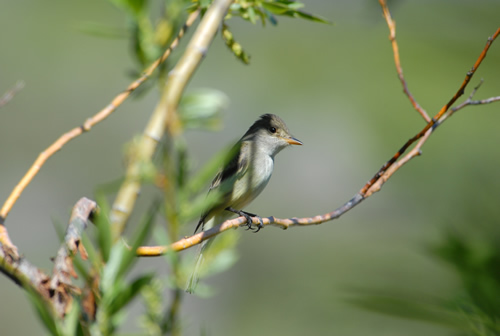
Southwestern willow flycatcher, photo by U.S. Fish and Wildlife Service
Two Trees, a Bird and a Beetle

Southwestern willow flycatcher, photo by U.S. Fish and Wildlife Service
When it comes to natural resources, too often it seems that we manage issues by running around in circles, chasing their tails so to speak. This example concerns two trees, a bird, and a beetle.
At one time, native willow trees lined all of our Southwest streams. These willows sheltered numerous nesting bird species, mammals, reptiles and fish. One bird nested in the willows so much it is named the Southwest willow flycatcher.
Then an invasive tree called tamarisk or saltcedar, invaded our stream banks. It crowds out native willows, dropping salt from its leaves and impregnating the ground so that other plants could not grow there. Tamarisk sucks much more water from the ground, reducing stream flows. It has been implicated in the decline of several fish and bird species including the willow flycatcher. Tamarisk spread quickly across the West, even invading Elko County streams. It lines the Grand Canyon along with most of the Colorado River.
Huge efforts have been attempted to eradicate or control this invasive plant. Often, crews are sent in to cut down tamarisk, carry out all cut material and spray the stumps with herbicides. Such controls are prohibitively expensive, and the National Park Service has given up removal attempts from the Grand Canyon.
But a bio-control has recently been found, and it works great. In carefully staged tests, the saltcedar leaf beetle killed its host trees and better yet, spread along the streams, killing more tamarisk. In southern Utah, a beetle release resulted in the beetle spreading 25 miles down the Virgin River to Arizona, killing tamarisk as it moves. It will soon reach the Colorado River and perhaps move upstream into the Grand Canyon, leaving behind a trail of dead tamarisk. Beetles have also been found near the beginning of the Grand Canyon, having moved downstream from beetle releases.
But there is a complication. The endangered Southwest willow flycatcher has learned to adapt to tamarisk and is beginning to nest in this willow replacement. This has caused the Maricopa Audubon Society and the Center for Biological Diversity to sue the U.S. Fish and Wildlife Service to stop the release of any more beetles. They are concerned that after beetles kill stretches of tamarisk, it will take too many years to return willows to these stretches, if they return at all given changes in the streams’ hydrology. These groups are afraid numerous invasive weeds would cover the stream banks long before native plants return. Mostly, they are afraid the Southwestern willow flycatcher will become extinct before native willows can return to the height needed to provide nesting sites.
Most of the states with tamarisk problems ado not have nesting willow flycatchers. Actually, the ban on beetle releases states no beetles may be carried across state lines for release. Of the seven states having nesting willow flycatchers, six have already released beetles so the ban does not apply to them. Since they already have beetles, they can continue to release more beetles. Many feel the ban will do little to stop beetle releases but will definitely stymy efforts to control tamarisk.
Nevada has nesting willow flycatchers, but only at the state’s southern tip. Since no beetles were released before the ban, we are now under the ban and cannot release saltcedar leaf beetles.
Basically, an endangered bird species is providing legal shelter for a destructive, invasive plant. Or another way to look at it is concern over one endangered bird species is overwhelming a chance to return native vegetation to hundreds of miles of stream banks, helping numerous species including the same flycatcher. So we continue to run in circles, chasing our tails.
Elko Daily Free Press, “Nature Notes”, 5/13/2011
© Gray Jay Press, Elko, NV
Return to Elko Nature Notes